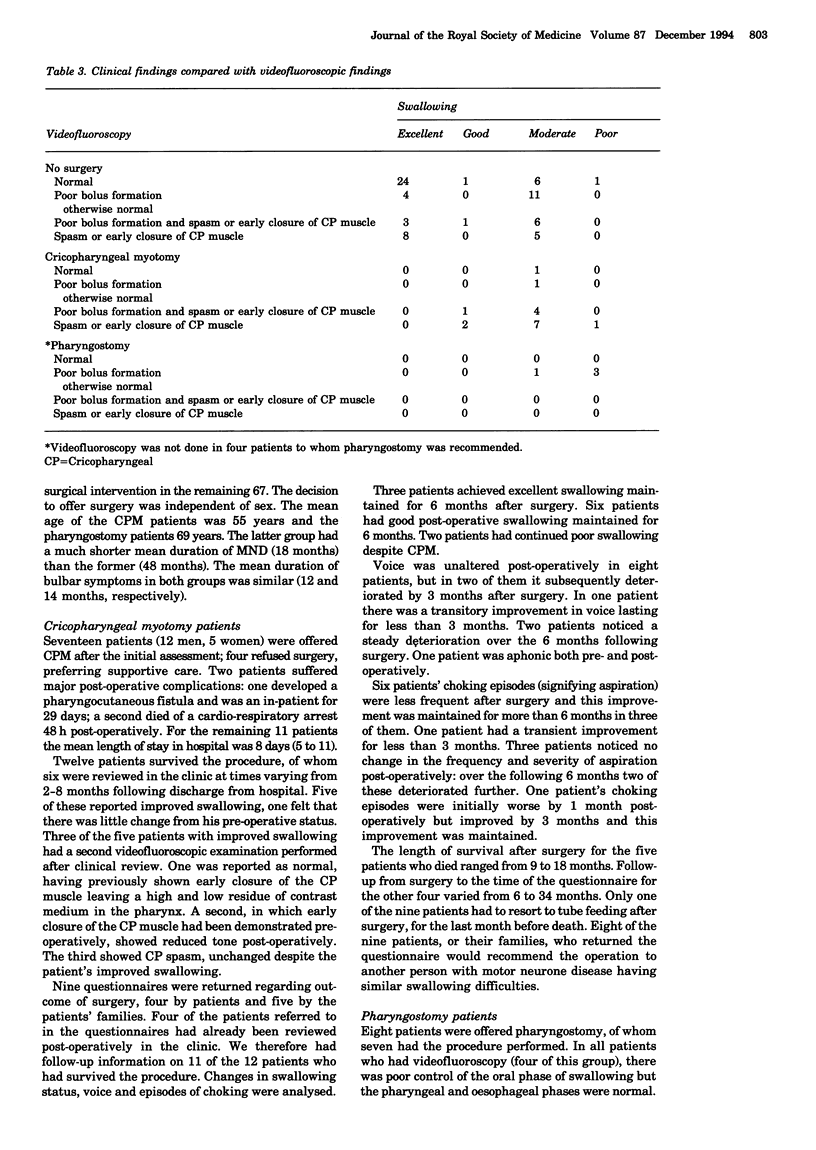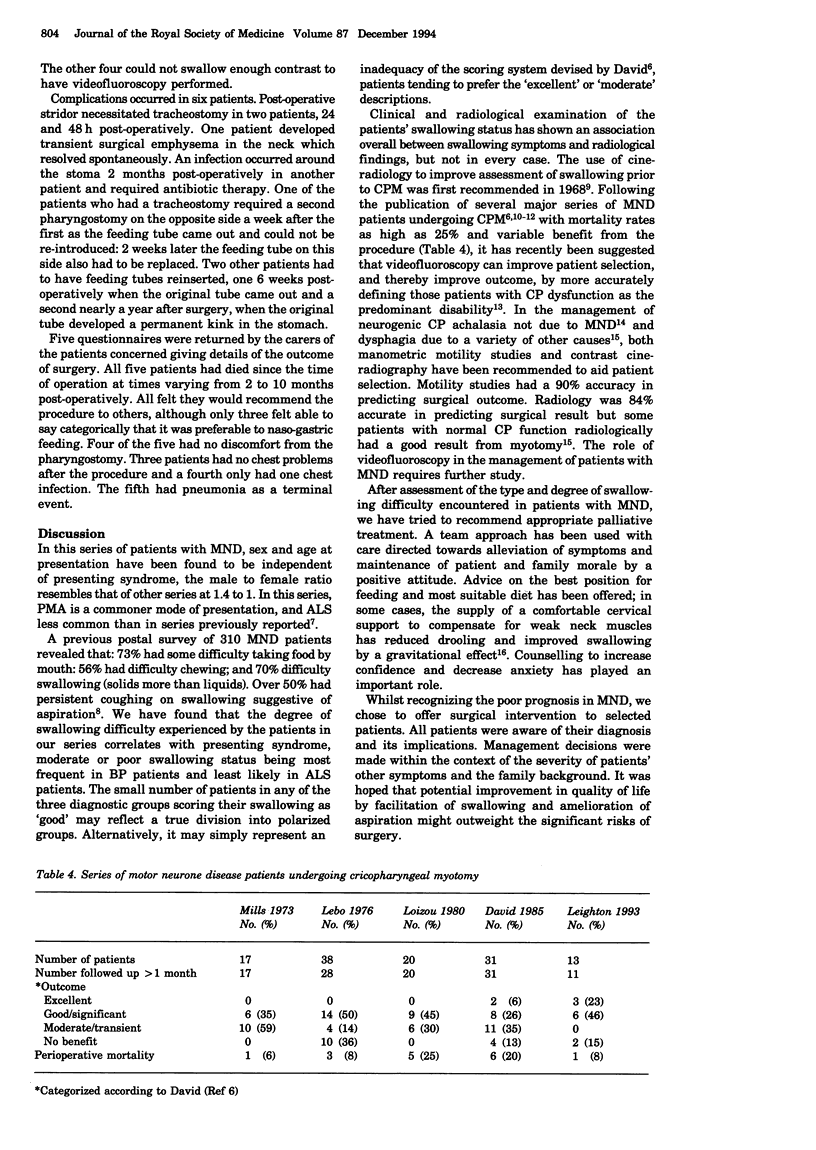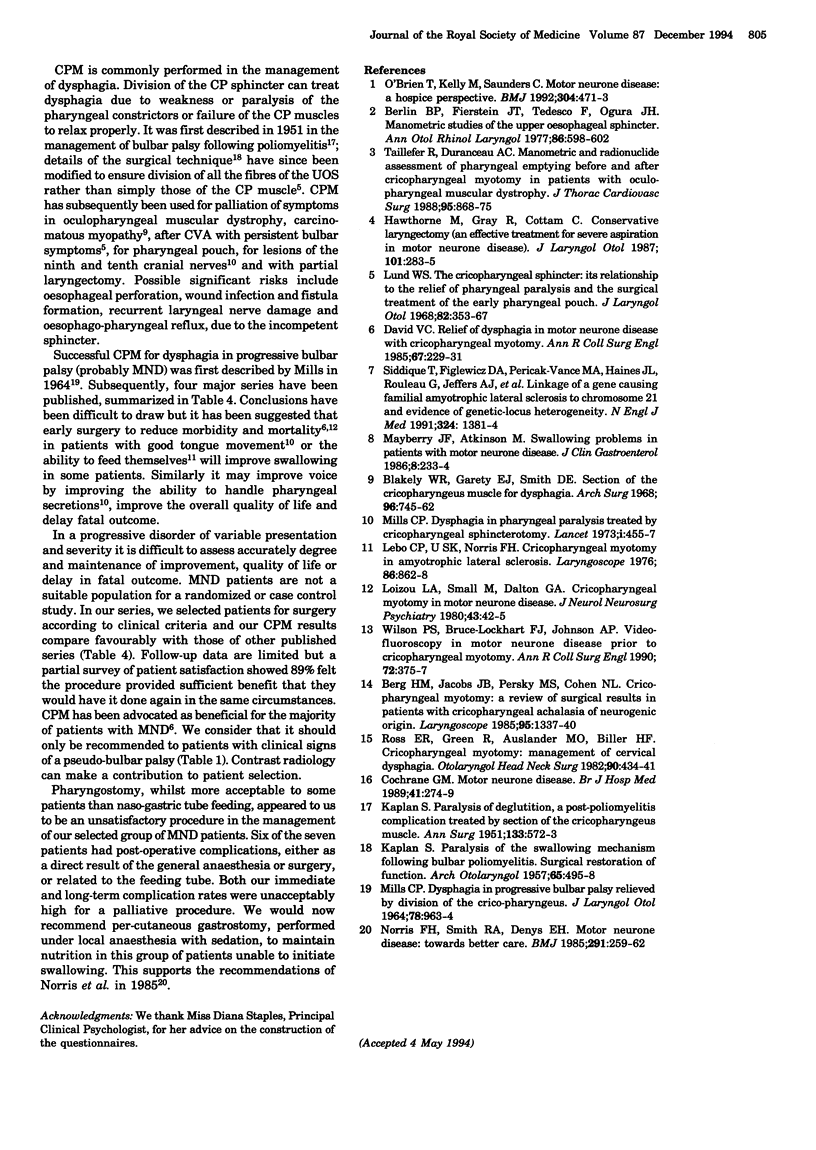Abstract
Ninety-two patients with motor neurone disease have been assessed clinically and radiologically for evidence of swallowing problems. At the time of examination, moderate or severe swallowing difficulty was present in 89% of those whose disease had presented as bulbar palsy, in 45% of those in whom the disease began many months before as progressive muscular atrophy and in 29% of those with amyotrophic lateral sclerosis. Patients with more severe swallowing symptoms appeared more likely to have abnormal findings on videofluoroscopy overall. However, not all patients with an abnormal radiological picture had swallowing difficulties. It is suggested that radiological signs should only be used within the context of clinical symptoms and signs in the selection of patients for palliative surgery. Thirteen patients with pseudobulbar symptoms and signs had a cricopharyngeal myotomy performed: two suffered major post-operative complications. However, the satisfaction rate was 89% and we recommend cricopharyngeal myotomy for such patients. Pharyngostomy was performed for seven patients unable to initiate swallowing, six had post-operative complications.
Full text
PDF




Selected References
These references are in PubMed. This may not be the complete list of references from this article.
- Berg H. M., Jacobs J. B., Persky M. S., Cohen N. L. Cricopharyngeal myotomy: a review of surgical results in patients with cricopharyngeal achalasia of neurogenic origin. Laryngoscope. 1985 Nov;95(11):1337–1340. doi: 10.1288/00005537-198511000-00008. [DOI] [PubMed] [Google Scholar]
- Berlin B. P., Fierstein J. T., Tedesco F., Ogura J. H. Manometric studies of the upper esophageal sphincter. Ann Otol Rhinol Laryngol. 1977 Sep-Oct;86(5 Pt 1):589–602. [PubMed] [Google Scholar]
- Blakeley W. R., Garety E. J., Smith D. E. Section of the cricopharyngeus muscle for dysphagia. Arch Surg. 1968 May;96(5):745–762. doi: 10.1001/archsurg.1968.01330230053008. [DOI] [PubMed] [Google Scholar]
- Cochrane G. M. Motor neurone disease. Br J Hosp Med. 1989 Mar;41(3):274–279. [PubMed] [Google Scholar]
- David V. C. Relief of dysphagia in motor neurone disease with cricopharyngeal myotomy. Ann R Coll Surg Engl. 1985 Jul;67(4):229–231. [PMC free article] [PubMed] [Google Scholar]
- Hawthorne M., Gray R., Cottam C. Conservative laryngectomy (an effective treatment for severe aspiration in motor neurone disease). J Laryngol Otol. 1987 Mar;101(3):283–285. [PubMed] [Google Scholar]
- KAPLAN S. Paralysis of deglutition, a post-poliomyelitis complication treated by section of the cricopharyngeus muscle. Ann Surg. 1951 Apr;133(4):572–573. doi: 10.1097/00000658-195104000-00021. [DOI] [PMC free article] [PubMed] [Google Scholar]
- KAPLAN S. Paralysis of the swallowing mechanism following bulbar poliomyelitis; surgical restoration of function. AMA Arch Otolaryngol. 1957 May;65(5):495–498. doi: 10.1001/archotol.1957.03830230071013. [DOI] [PubMed] [Google Scholar]
- Lebo C. P., U K. S., Norris F. H., Jr Cricopharyngeal myotomy in amyotrophic lateral sclerosis. Laryngoscope. 1976 Jun;86(6):862–868. doi: 10.1288/00005537-197606000-00013. [DOI] [PubMed] [Google Scholar]
- Loizou L. A., Small M., Dalton G. A. Cricopharyngeal myotomy in motor neurone disease. J Neurol Neurosurg Psychiatry. 1980 Jan;43(1):42–45. doi: 10.1136/jnnp.43.1.42. [DOI] [PMC free article] [PubMed] [Google Scholar]
- Lund W. S. The cricopharyngeal sphincter: its relationship to the relief of pharyngeal paralysis and the surgical treatment of the early pharyngeal pouch. J Laryngol Otol. 1968 Apr;82(4):353–367. doi: 10.1017/s0022215100068857. [DOI] [PubMed] [Google Scholar]
- MILLS C. P. DYSPHAGIA IN PROGESSIVE BULBAR PALSY RELIEVED BY DIVISION OF THE CRI-PHARYNGEUS. J Laryngol Otol. 1964 Oct;78:963–964. doi: 10.1017/s0022215100063039. [DOI] [PubMed] [Google Scholar]
- Mayberry J. F., Atkinson M. Swallowing problems in patients with motor neuron disease. J Clin Gastroenterol. 1986 Jun;8(3 Pt 1):233–234. doi: 10.1097/00004836-198606000-00005. [DOI] [PubMed] [Google Scholar]
- Mills C. P. Dysphagia in pharyngeal paralysis treated by cricopharyngeal sphincterotomy. Lancet. 1973 Mar 3;1(7801):455–457. doi: 10.1016/s0140-6736(73)91881-3. [DOI] [PubMed] [Google Scholar]
- Norris F. H., Smith R. A., Denys E. H. Motor neurone disease: towards better care. Br Med J (Clin Res Ed) 1985 Jul 27;291(6490):259–262. doi: 10.1136/bmj.291.6490.259. [DOI] [PMC free article] [PubMed] [Google Scholar]
- O'Brien T., Kelly M., Saunders C. Motor neurone disease: a hospice perspective. BMJ. 1992 Feb 22;304(6825):471–473. doi: 10.1136/bmj.304.6825.471. [DOI] [PMC free article] [PubMed] [Google Scholar]
- Ross E. R., Green R., Auslander M. O., Biller H. F. Cricopharyngeal myotomy: management of cervical dysphagia. Otolaryngol Head Neck Surg. 1982 Jul-Aug;90(4):434–441. doi: 10.1177/019459988209000413. [DOI] [PubMed] [Google Scholar]
- Siddique T., Figlewicz D. A., Pericak-Vance M. A., Haines J. L., Rouleau G., Jeffers A. J., Sapp P., Hung W. Y., Bebout J., McKenna-Yasek D. Linkage of a gene causing familial amyotrophic lateral sclerosis to chromosome 21 and evidence of genetic-locus heterogeneity. N Engl J Med. 1991 May 16;324(20):1381–1384. doi: 10.1056/NEJM199105163242001. [DOI] [PubMed] [Google Scholar]
- Taillefer R., Duranceau A. C. Manometric and radionuclide assessment of pharyngeal emptying before and after cricopharyngeal myotomy in patients with oculopharyngeal muscular dystrophy. J Thorac Cardiovasc Surg. 1988 May;95(5):868–875. [PubMed] [Google Scholar]
- Wilson P. S., Bruce-Lockhart F. J., Johnson A. P. Videofluoroscopy in motor neurone disease prior to cricopharyngeal myotomy. Ann R Coll Surg Engl. 1990 Nov;72(6):375–377. [PMC free article] [PubMed] [Google Scholar]


